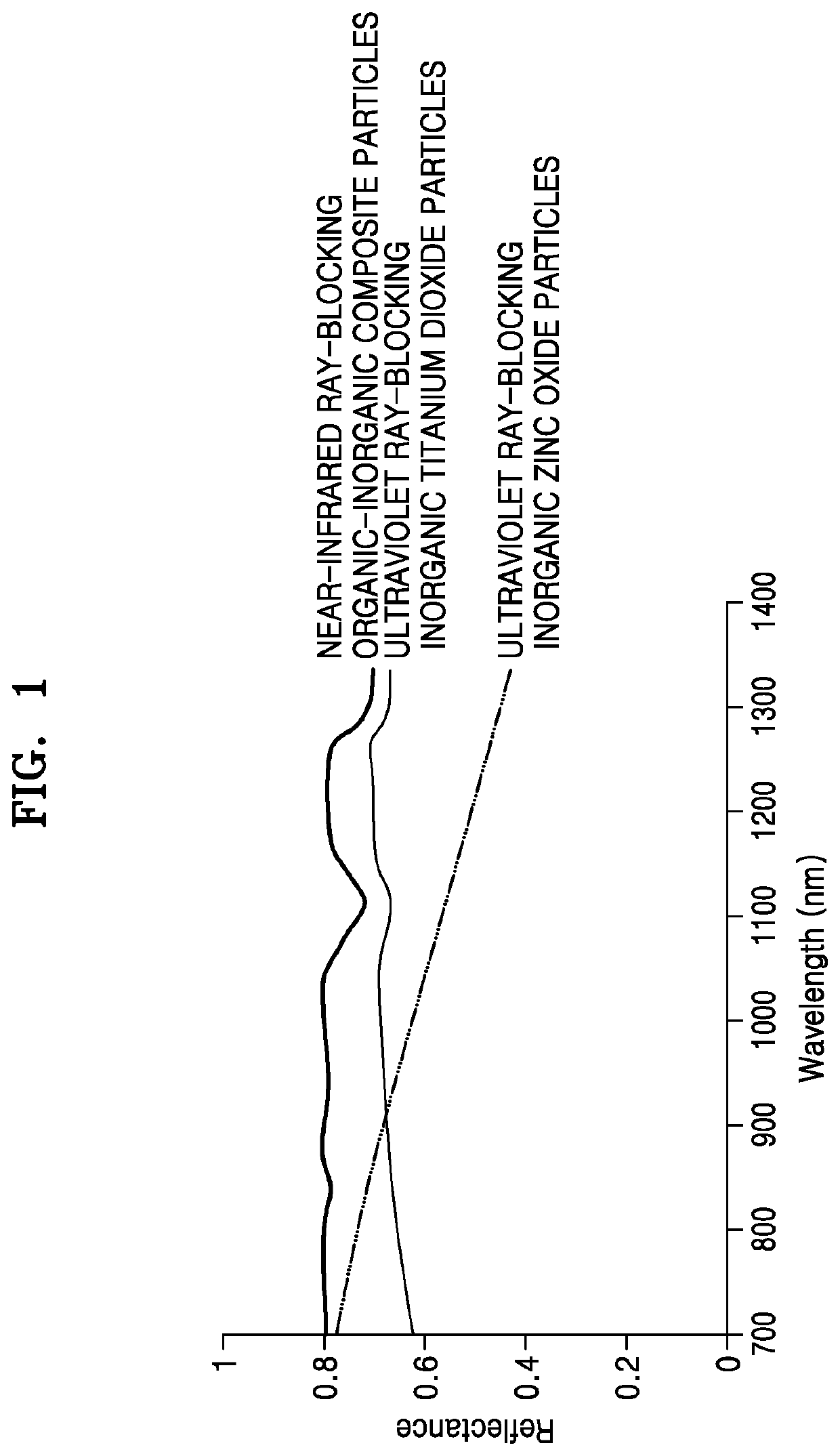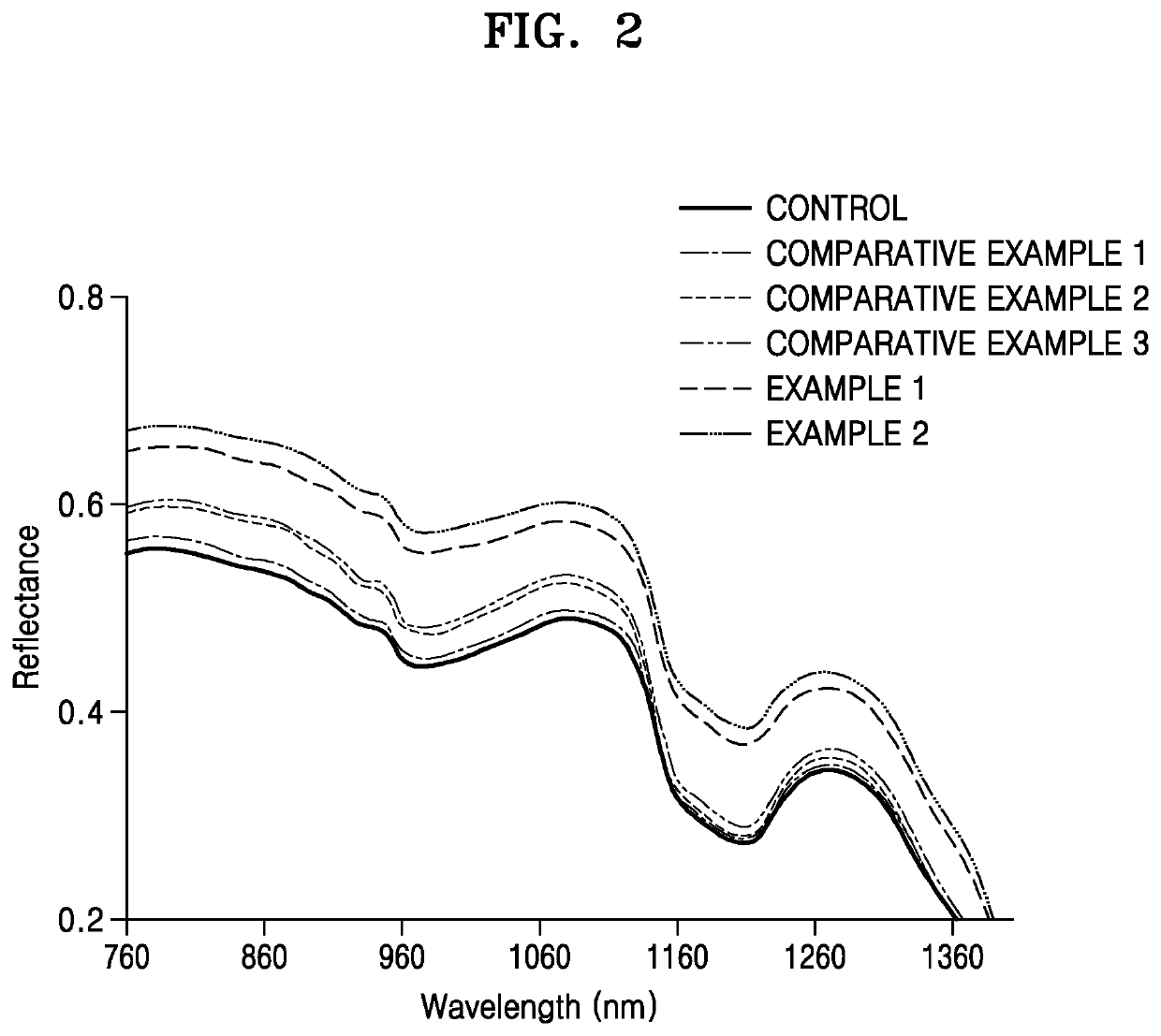Cosmetic composition containing organic-inorganic composite particles for blocking near infrared rays
a technology of organic inorganic composite particles and cosmetic compositions, which is applied in the direction of cosmetic preparations, medical preparations, cosmetic preparations, etc., can solve the problems of skin aging such as loss of elasticity, skin damage, and inability to develop materials and products for blocking near-infrared rays, and achieve the effect of preventing skin aging
- Summary
- Abstract
- Description
- Claims
- Application Information
AI Technical Summary
Benefits of technology
Problems solved by technology
Method used
Image
Examples
example 1
Preparation of Cosmetic Composition for Blocking Near-Infrared Rays Including 2.5% by Weight of Organic-Inorganic Composite Particles for Blocking Near-Infrared Rays
[0042]A cosmetic composition of Example 1 was prepared as in a composition described in Table 1.
[0043]In detail, organic-inorganic composite particles having a hollow spherical form, in which titanium dioxide was dispersed in a polymer poly(methyl methacrylate) (PMMA), were first prepared as organic-inorganic composite particles for blocking near-infrared rays.
[0044]First, 0.60 g of methyl methacrylate (MMA) and 0.106 g of ethylene glycol dimethacrylate (EDGMA) were mixed, and then 0.015 g of 2 wt % CR-50 (manufactured by Ishihara Sangyo Kaisha) which is a commercial product of titanium dioxide nanoparticles was dispersed therein. Next, 0.15 g (20wt % with respect to MMA, MW: 120,000) of poly(methyl methacrylate) (PMMA) which is a linear polymer material was added thereto, followed by sonication for about 1 hour and 30 m...
example 2
Preparation of Cosmetic Composition for Blocking Near-Infrared Rays Including 5.0% by Weight of Organic-Inorganic Composite Particles for Blocking Near-Infrared Rays
[0046]A cosmetic composition of Example 2 was prepared as in a composition described in the following Table 1. In detail, 5.0% by weight of the organic-inorganic composite particles for blocking near-infrared rays including the inorganic material which were prepared in the same manner as in Example 1 were mixed with and dispersed in oil phase, and dissolved by heating at 70° C. to 80° C. Thereafter, an aqueous phase was added thereto, followed by stirring.
[0047]Examples 1 and 2 were prepared in order to compare the near-infrared ray-blocking effects according to contents of the known UV-blocking inorganic material and the near-infrared ray-blocking organic-inorganic composite particles.
experimental example 1
Evaluation of Near-Infrared Ray-Blocking Ability Using Near-Infrared Spectrophotometer
[0052]In order to evaluate near-infrared ray-blocking ability of the organic-inorganic composite particles for blocking near-infrared rays prior to application of the particles to formulations, a near infrared spectrophotometer (NIR spectrophotometer, ASD Inc., USA) was used to measure spectral reflectance.
[0053]The wavelength region of near-infrared rays is 760 nm to 1400 nm, and in this region, higher spectral reflectance indicates higher near-infrared ray-blocking ability. Results of measuring spectral reflectance of the known UV-blocking inorganic particles and the near-infrared ray-blocking organic-inorganic composite particles are shown in FIG. 1.
[0054]Evaluation of the near-infrared ray-blocking ability is obtained by the reflectance measurement. Since organic materials generally absorb lights, the near-infrared ray-blocking ability was evaluated only for the UV-blocking inorganic particles ...
PUM
| Property | Measurement | Unit |
|---|---|---|
| surface roughness | aaaaa | aaaaa |
| surface roughness | aaaaa | aaaaa |
| RMS surface roughness | aaaaa | aaaaa |
Abstract
Description
Claims
Application Information
 Login to View More
Login to View More - R&D
- Intellectual Property
- Life Sciences
- Materials
- Tech Scout
- Unparalleled Data Quality
- Higher Quality Content
- 60% Fewer Hallucinations
Browse by: Latest US Patents, China's latest patents, Technical Efficacy Thesaurus, Application Domain, Technology Topic, Popular Technical Reports.
© 2025 PatSnap. All rights reserved.Legal|Privacy policy|Modern Slavery Act Transparency Statement|Sitemap|About US| Contact US: help@patsnap.com


